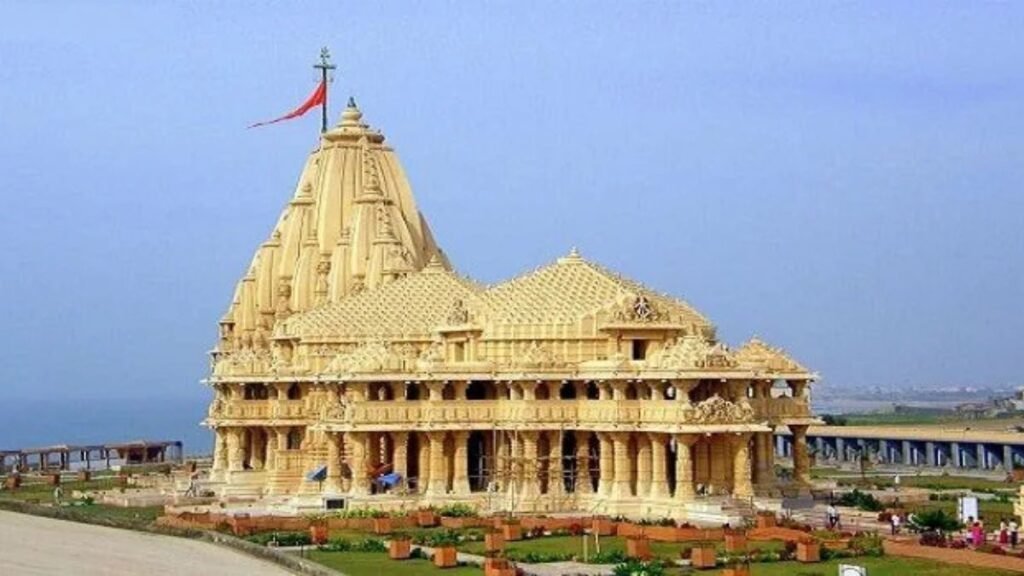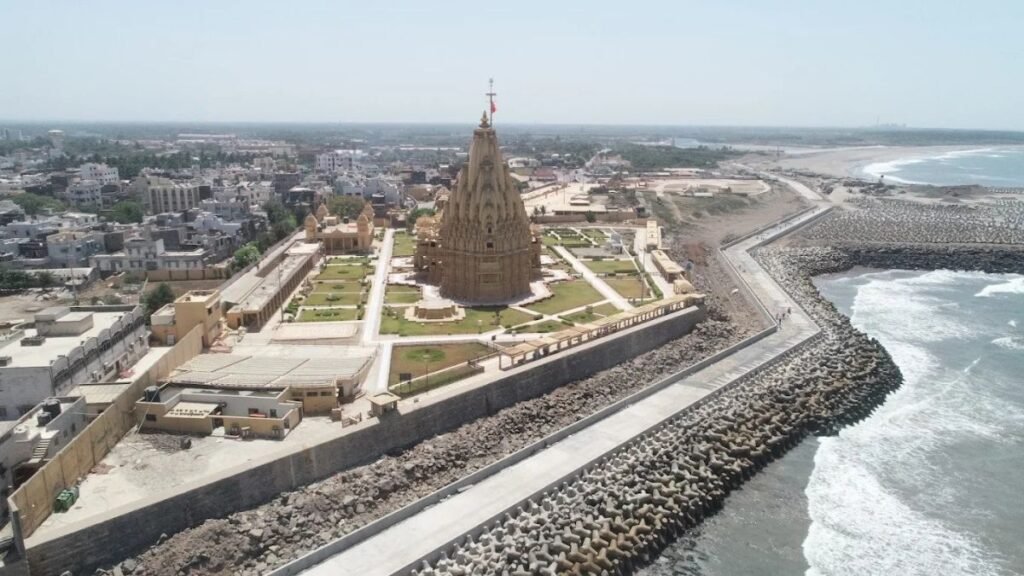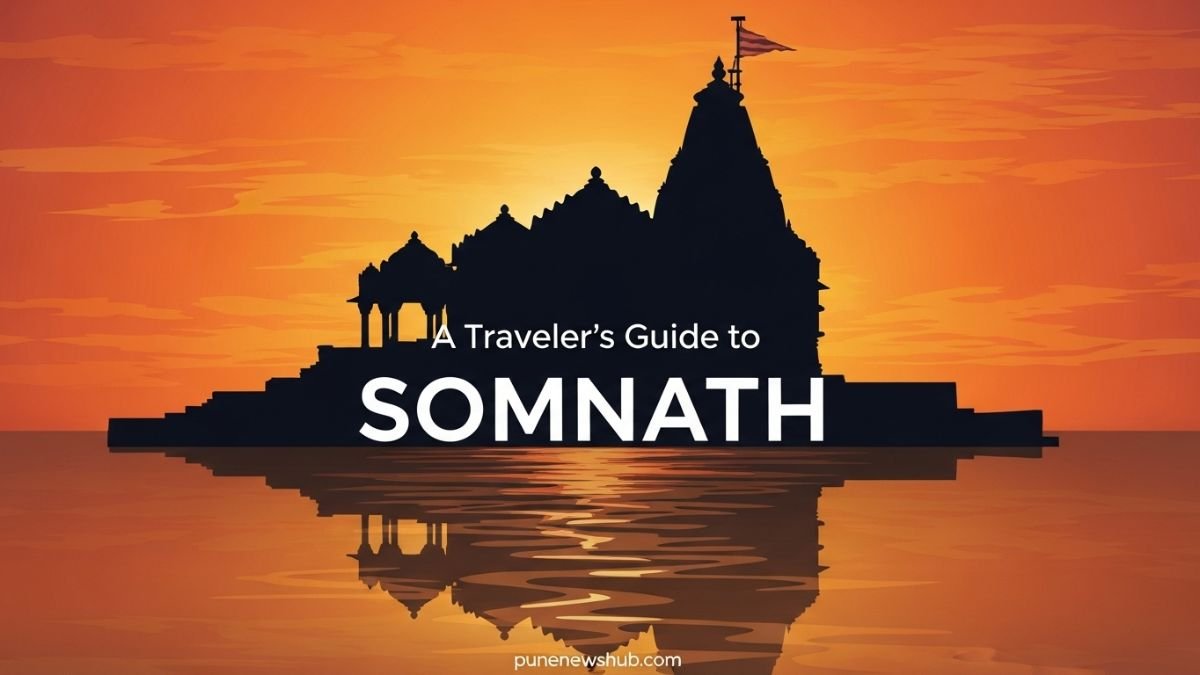Have you ever stood in a place so ancient and powerful that you could feel the whispers of history in the air? That’s exactly how I felt the moment I first laid my eyes on the magnificent Somnath Temple. Washed by the waves of the Arabian Sea on the coast of Gujarat, this isn’t just a temple; it’s a symbol of faith, resilience, and incredible stories that have echoed through centuries.
I remember the sea breeze on my face and the sound of bells ringing in the distance. It was magical. For years, I had heard tales of this legendary place, the first of the twelve sacred Jyotirlingas of Lord Shiva. But let me tell you, no story does it justice. You have to be there.
So, grab a cup of chai, get comfortable, and let me take you on a journey to this eternal shrine. I’ll share everything you need to know to plan your own unforgettable trip, from its jaw-dropping history to the best local food and practical tips that I wish I’d known before I went. Ready? Let’s go!
Raghunath Mandir Jammu: Your Ultimate Guide (2025)
A Little Background: Why is Somnath So Special?
So, what’s the big deal about the Somnath Temple? Well, in Hinduism, a Jyotirlinga is a sacred shrine where Lord Shiva is worshipped as a “pillar of light.” There are twelve of these across India, and Somnath is considered the very first one. Think of it as the original, the OG of Shiva temples!
This makes it one of the most revered pilgrimage sites for Hindus worldwide. People travel from every corner of the globe just to get a glimpse of the divine energy here. The name “Somnath” itself means “Lord of the Moon,” and its origin story is tied to Soma, the Moon God himself. It’s a place where myth, history, and spirituality all meet in one breathtaking location.

The Jaw-Dropping History of Somnath: A Tale of Plunder and Resilience
Honestly, the history of the Somnath Temple reads like an epic movie script. It’s a story of being built, destroyed, and rebuilt again and again. It’s a true testament to the power of faith.
The Mythical Beginnings
Legend has it that the original temple was built by the Moon God, Soma, entirely out of gold! Why? He was praying to Lord Shiva to be freed from a curse. As time went on, the temple was said to have been rebuilt by Ravana in silver, then by Lord Krishna in sandalwood, and later by King Bhimdev in stone. Each era added its own layer to the legend.
A Cycle of Destruction and Rebirth
This is where the story gets intense. Because of its legendary wealth, the Somnath Temple was a target for invaders for centuries.
- The Infamous Raid: The most famous attack was in 1026 AD by the Afghan ruler Mahmud of Ghazni. He looted the temple’s treasures and destroyed it.
- The Attacks Continued: But that wasn’t the end. The temple was rebuilt, only to be attacked again by invaders like Alauddin Khilji and the Mughal emperor Aurangzeb.
- The Spirit of Resilience: Yet, every single time it was torn down, the devotees and local rulers would come together to rebuild it. This cycle happened at least six times! It’s why Somnath is often called the “Eternal Shrine.” It simply refused to be erased.
The Modern Marvel We See Today
The temple you see today was reconstructed in 1951, after India gained its independence. The project was spearheaded by Sardar Vallabhbhai Patel, a key figure in India’s freedom movement. It was a proud moment for the entire nation, symbolizing the revival of India’s cultural heritage.
Getting There: Your Route to a Divine Destination
Reaching Somnath is easier than you might think. It’s well-connected, and you have a few options.
| Mode of Transport | Nearest Hub | Details & My Tips |
| By Air | Diu Airport (DIU) | About 80 km away. You can easily find a taxi from the airport. The drive is scenic! |
| By Train | Veraval Railway Station (VRL) | This is the closest station, just 7 km from the temple. Autos and taxis are readily available. |
| By Road | Well-connected by bus | GSRTC buses run from major Gujarat cities like Ahmedabad, Rajkot, and Junagadh. I took a bus, and it was comfortable and affordable. |
Where to Stay: Comfort Near the Coast
You’ll find plenty of accommodation options near the temple to suit every budget.
- For Luxury & Comfort: The Fern Residency and Lords Inn Somnath offer great amenities and are very close to the temple.
- For Mid-Range Options: Sagar Darshan Atithigruh is a fantastic choice. It’s run by the temple trust and offers stunning sea-facing rooms. Book in advance!
- For Budget Travelers: There are many guesthouses (dharamshalas) and budget hotels in the area that are clean and safe.
My tip? Try to get a sea-facing room. Waking up to the sound of the ocean waves is an experience in itself.

Food & Drink: A Taste of Gujarat
You can’t visit Gujarat and not indulge in the local food! The area around Somnath offers delicious vegetarian cuisine.
- Gujarati Thali: You MUST try this. It’s an all-you-can-eat platter with a variety of curries, bread, rice, and sweets. It’s a flavor explosion!
- Local Snacks: Look for stalls selling dhokla, fafda, and khaman. They are perfect for a quick bite.
- Prasad at the Temple: Don’t miss the prasad (blessed food offering) from the temple. It’s simple but incredibly soulful.
Most restaurants here are pure vegetarian and do not serve alcohol, in keeping with the sanctity of the place.
Things to Do / Must-See Attractions
While the Somnath Temple is the main star, there’s a lot more to explore in the vicinity.
Inside the Somnath Temple Complex
The main temple itself is a marvel. Take your time to walk around.
- The Main Sanctum: This is where the sacred Jyotirlinga is housed. The energy here is palpable.
- The Arrow Pillar (Baan Stambh): This is fascinating! It’s a pillar on the temple grounds with an arrow pointing towards the sea. An inscription on it states that there is no land in a straight line between this point and the South Pole! How cool is that?
- The Light and Sound Show: Don’t miss the evening show. It narrates the temple’s history with stunning visuals projected onto the temple itself. It gave me goosebumps.
Nearby Spiritual Spots
- Bhalka Tirth: This is the sacred spot where Lord Krishna is said to have left his mortal body after being accidentally struck by an arrow. It’s a very serene and moving place.
- Triveni Sangam: This is the holy confluence of three rivers: Hiran, Kapila, and the mythical Saraswati. You can take a holy dip here and see countless devotees performing rituals.
Cultural Insights & Etiquette: How to Be a Respectful Visitor
To make the most of your visit, it’s important to be mindful of the local culture.
- Dress Code: Dress modestly. This means covering your shoulders, chest, and knees. Both men and women should avoid shorts and sleeveless tops.
- No Leather: Leather items like belts and wallets are not allowed inside the main temple. You can store them in lockers available at the entrance.
- Photography: Photography is strictly prohibited inside the temple sanctum. You can take pictures of the exterior.
- Mobile Phones: You have to deposit your phone and other electronic gadgets at the free locker facility before entering. It’s actually a blessing—it allows you to be fully present.
Budgeting Tips: A Divine Trip That Won’t Break the Bank
A trip to Somnath can be very budget-friendly.
- Stay: Opt for the temple trust’s guesthouses for affordable and clean lodging.
- Food: Eat at local eateries and enjoy the delicious and inexpensive Gujarati thalis.
- Transport: Use local auto-rickshaws for short distances but be sure to agree on a fare beforehand.
Packing Tips: What to Bring Along
- Comfortable and modest clothing (cotton is great for the weather).
- A scarf or stole to cover your head if you wish.
- Comfortable walking shoes.
- Sunscreen and a hat.
- A reusable water bottle.
- A small bag for essentials, as you’ll have to deposit bigger bags.
Personal Experiences & Stories: My Unforgettable Moment
I’ll never forget the evening aarti (prayer ceremony). The temple was illuminated, the sound of hymns filled the air, and the entire atmosphere was electric with devotion. Standing there, with hundreds of other people, I felt a deep sense of peace and connection. It wasn’t just a religious ritual; it was a shared human experience of faith and wonder. It’s moments like these that make travel so meaningful. It reminded me of a similar feeling of awe I once had at the Raghunath Mandir in Jammu, another incredibly spiritual place, but the seaside setting of Somnath adds a unique magic.
Travel Tips & Takeaways: My Advice for You
- Visit during Aarti: Try to attend the morning or evening aarti. It’s an incredible experience. Check the timings beforehand.
- Plan for Crowds: The temple is busiest during festivals like Mahashivratri and on Mondays. If you prefer quiet, visit on a weekday.
- Stay Hydrated: The Gujarat sun can be strong, so drink plenty of water.
- Be Patient: There can be long queues, especially for darshan (viewing the deity). Embrace it as part of the pilgrimage experience.
Checklist Before You Go
- Booked accommodation (especially if traveling during peak season).
- Packed modest clothing.
- Checked temple timings online.
- Arranged transport from the airport/station.
- Have small currency for local expenses.
- Downloaded an offline map of the area.
Suggested Itinerary (2 Days)
Day 1: Spiritual Immersion
- Morning: Arrive in Somnath, check into your hotel.
- Afternoon: Visit Bhalka Tirth and Triveni Sangam.
- Evening: Attend the evening aarti at Somnath Temple, followed by the Light and Sound Show.
Day 2: Exploration and Departure
- Morning: Visit the Somnath Temple again for morning darshan when it’s peaceful. Explore the temple complex thoroughly.
- Afternoon: Enjoy a traditional Gujarati thali for lunch and do some souvenir shopping.
- Evening: Depart from Somnath with a full heart.
Unique Facts about Somnath Temple
- The temple is situated at a point where there is no landmass in a straight line to Antarctica.
- The Shiva lingam inside is believed to be swayambhu, meaning it emerged naturally from the earth.
- The temple trust has its own dairy, and the milk produced there is used for the daily rituals.
Tips and Assistance for Elders
Somnath is very accessible for senior citizens.
- Wheelchair Access: Free wheelchair services are available at the entrance for those who need them.
- Seating: There are plenty of benches and seating areas around the temple complex for resting.
- Special Queues: Sometimes, there are separate, shorter queues for senior citizens and people with disabilities. Don’t hesitate to ask a volunteer.
Your Turn!
I hope this guide helps you plan your own magical trip to the Somnath Temple. It’s a journey that will stay with you long after you’ve left.
Have you been to Somnath? What was your favorite part? Share your stories in the comments below! I’d love to hear from you.
Useful Resources & Links
- Official Temple Website: https://somnath.org/ (For official timings, accommodation booking, and information)
- Gujarat Tourism: https://www.gujarattourism.com/ (For broader travel information about the state)
Frequently Asked Questions (FAQs)
Q1: What are the timings of the Somnath Temple?
The temple is generally open from 6:00 AM to 10:00 PM. The aarti timings are usually around 7:00 AM, 12:00 PM, and 7:00 PM, but it’s always best to check the official website for the latest schedule.
Q2: Is there an entry fee for the Somnath Temple?
No, entry into the temple is completely free for everyone.
Q3: How much time is needed to see the Somnath Temple?
I would recommend at least 2-3 hours to explore the main temple complex properly, without rushing. If you plan to attend the aarti and the light show, you’ll need more time.
Q4: Can I take my camera inside?
No, cameras, mobile phones, and any electronic gadgets are not allowed inside the temple premises. You have to deposit them at the locker facility near the entrance.
Q5: What is the best time to visit Somnath?
The best time to visit is from October to March when the weather is pleasant. The summers can be very hot, and the monsoon season brings heavy rain.


